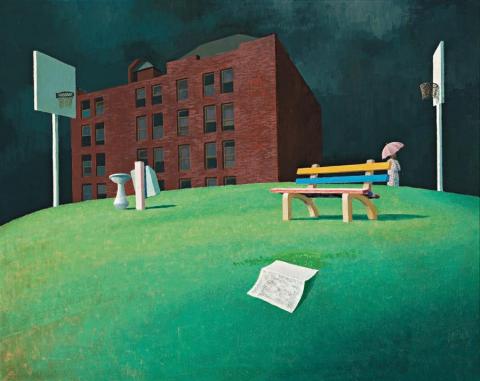THE PARK, 1960
JEFFREY SMART
oil on plywood
59.0 x 76.0 cm
signed lower left: JEFFREY SMART
signed and inscribed verso: MC.CAUGHEY PRIZE / "PARK" 75gns / Jeffrey Smart
A.G.B. Burney, London
Private collection, Melbourne
Sotheby's, Melbourne, 27 August 2007, lot 10
Private collection, Sydney
Recent Australian Painting,1961, Whitechapel Gallery,
London, June – July 1961, cat. 100 (label attached verso, as cat. 38)
Robertson, B., (ed.), Recent Australian Painting, 1961, The Arts Council of Great Britain, London, 1961, p. 28
Allen, C., Jeffrey Smart, Unpublished Paintings, Australian Galleries, Melbourne, 2008, p. 95 (illus.)
Jeffrey Smart's paintings have an abiding theatrical or cinematic quality about them. Objects are spotlit, as in The Park, 1960, and figures move over crests of hills into the unknown, offstage. The singular pictorial statements of newspaper, park bench, rubbish bin and building in The Park increases visual tension and adds to the atmosphere of expectancy akin to that in a film by Alfred Hitchcock. Aided by the glare of the foreground light cast from outside the picture against the darkened sky, the heightened reality creates a Surreal sense of the unreal, crafted with a mastery of composition and colour to entice the viewer. Smart plays with perspective from multi-viewpoints in a painting rich in visual irony. Form echoes form, and colour repeats colour - the curve of the umbrella found in the hoops of the basketball frames and drinking fountain, and the umbrella's pink recited in the post and bench. Many of the elements are familiar from earlier works such as Approaching Storm by Railway, 1955 with its objects of isolation, and ever-dramatic interplay of light and dark. In The Park and other works, the captured moment is suspended in stillness, expectant with anticipation. What will transpire remains unanswered. Some years later Smart wrote,'As a young man I used to deplore the restrictions of painting - how to express 'cosmic ecstasy' as in Mahler's 2nd, Beethoven's 9th. [T.S.] Eliot reminded me, pointed the way to accepting that we painters can express 'the still moment' ...'.1
Painted in Sydney a few years before Smart left to settle in Italy, parks had provided his fertile imagination with many subjects of interest. His 1961 solo exhibition at the Macquarie Galleries included Beare Park and Trumper Park. Cooper Park, 1962 and The Park, 1963 (National Gallery of Australia, Canberra) followed. Then, from Italy, came The Listeners, 1965 (Art Gallery of Ballarat, Victoria), featuring that pregnant swell seen in the green foreground of our painting.
The Park is a significant painting in Smart's oeuvre, being one of two works by the artist included in the major London exhibition, Recent Australian Painting, 1961, held at the Whitechapel Gallery. A milestone in the international recognition of Australian art, the other painting was The Stilt Race, 1960 in the collection of the Art Gallery of New South Wales, Sydney. This was followed by the exhibition, Australian Painting: Colonial, Impressionist, Contemporary, with Cooper Park being one of three paintings chosen to represent Smart in the official survey shown at the Tate Gallery, London, and the National Gallery in Ottawa.
1. Quoted in Pearce, B., Jeffrey Smart, Beagle Press, Sydney, 2005, p. 193
DAVID THOMAS
